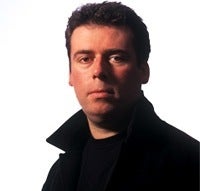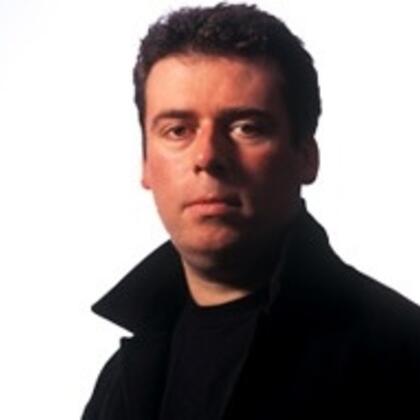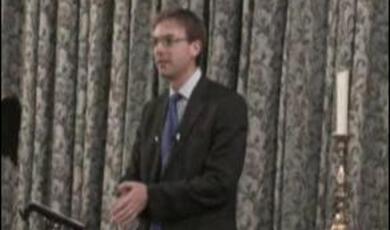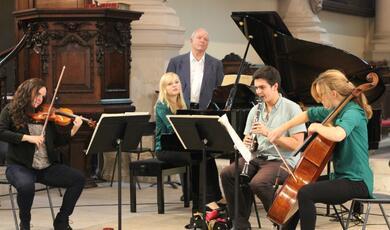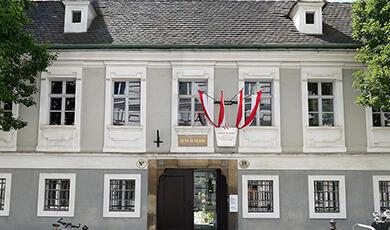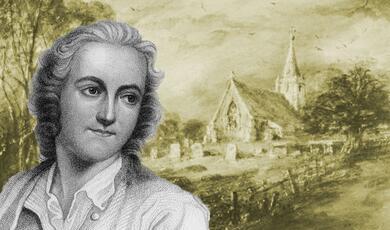Music and Architecture: Confronting the Boundaries between Space and Sound
Share
- Details
- Transcript
- Audio
- Downloads
- Extra Reading
The architect/mathematician turned composer, Iannis Xenakis, was Gresham Professor of Music between 1975 to 1978, and died in 2001. Professor Xenakis was the 20th century's best example of a creator who linked these disciplines at the highest level. This lecture will be about Xenakis and the mathematical links between music and architecture. Jonathan Cole is a composer and a professor of composition at the Royal College of Music.
Download Transcript
MUSIC AND ARCHITECTURE: CONFRONTING THE BOUNDARIES BETWEEN SPACE AND SOUND
Professor Jonathan Cole
My talk this evening is an exploration of the relationship between physical space and musical space. I will explore some of the links which exist between musical composition and architecture. I will look at how composers have used physical space within their methodology and how the architecture of our environment can open up new possibilities within the development of musical ideas.
At various points within the lecture, in order to provide some respite, I will be playing excerpts of a selection of pieces which explore the ideas of musical space in individually imaginative ways. Obviously, with a stereophonic setup, it is impossible to experience the specific spatial arrangement of these pieces, and a lack of time means I cannot play extensive excerpts. However, I hope that if you are unfamiliar with these pieces, the tasters I offer may tempt you to investigate these composers further.
A lack of time also means I am not able to include a fully comprehensive study of this subject. Many important composers and theorists have inevitably been left out, and such giants as Luigi Nono and Pierre Boulez could feature as the subject of a series of talks to themselves. However, I hope that what follows will prove to be an interesting introduction to a fascinating subject.
Imagine, if you will, that we are able to look inside the mind of the composer at various stages of the creative process. We follow the growth of musical ideas once they have taken root. We observe how some of these are rejected due to their seemingly stubborn refusal to develop into a satisfying and potent form. Other ideas remain and slowly move towards a clear point of identity. Isolated possibilities establish themselves within a collective interplay of thoughts and processes, and slowly, as the mists of confusion lift and the possibility of choices become increasingly limited, a clearly defined context is revealed and a structuralisation of ideas begins to emerge.
This is of course a generalised account of a complex process, which, for each composer, will be a highly personal and individual experience. However, if we return to our hypothetical investigation, and examine the point at which an idea, in the mind of our composer, moves from being a possibility into a reality within the evolving structure, we notice in that moment of clarity the musical material has taken on an almost physical presence.
From my own experience at this point of epiphany, the inner soundscape is no longer defined purely by an aural dimension, but is clarified and supported by a visualisation of the musical components. With this synthesis between the visual and aural senses, the imagination is able to conceive of a sonic world in which perspective, gravity, weight, height, balance and density are present within the musical material. In short, the physicality of the timbrel structure is revealed. Although the visualisation of musical patterns and shapes in our imagination are drawn from visual memories, that is translations of our everyday experiences into musical figurations, the visual does not detract from the aural but rather becomes an imaginary equivalent of the corporeal properties of sound.
The Italian composer, Fausto Romitelli, eloquently described the importance of this aspect within his own work: 'At the centre of my composing lies the idea of considering sound as a material into which one plunges in order to forge its physical and perceptive characteristics - grain, thickness, porosity, luminosity, density and elasticity. Hence it is sculpture of sound, instrumental synthesis, anamorphosis, transformation of the spectral morphology, and a constant drift towards unsustainable densities, distortions and interferences.'
Our awareness and knowledge of the physicality of sound components has greatly increased with the development of electro-acoustic technologies. France is a country whose composers have long been experts in creating refined timbres, so it is no surprise that in the 1970s a group of French composers developed a technical and aesthetic approach which has since become known as spectralism. This involves analysing the structure of sound waves using a system named fast fourier transform, which enables details of the timbrel components to be identified and used within the compositional method.
Tristan Murail, Gerard Grisey, and Hugues Dufourt were initiators of this approach, although it can be viewed as a natural outcome of the sonic experiments of such composers as Olivier Messiaen, Karlheinz Stockhausen, Edgard Varese and others.
The Italian composer Luigi Nono was also a hugely influential figure in exploring the inner life of sounds, creating a musical universe where we, the listeners, are drawn into the internal workings of timbre.
Returning to the internal processes of the mind of our guinea pig composer, as the physical dimensions of sound become apparent within the composer's mind, so they create a virtual environment of musical space. During the gestation process, this internal imaginary landscape adapts to the transformations taking place within the musical material. Eventually, the ideas are born into reality in the external environment of performance.
The necessary progression from internal to external experience which underlines the creative process and the change of intensity within our sense which accompanies this journey has been vividly described by Kandinsky in Point and Line to Plane: 'The street can be observed through the windowpane, which diminishes its sounds so that its movements become phantom-like. The street itself, as seen through a transparent yet hard and firm pane, seems set apart, existing and pulsating as if beyond. As soon as we open the door, step out of the seclusion and plunge into the outside reality, we become an active part of this reality and experience its pulsation with all our senses. The constantly changing grades of tonality and tempo of the sounds wind themselves about us, rise spirally and suddenly collapse. Likewise, the movements envelop us by a play of horizontal and vertical lines bending in different directions, as colour patches pile up and dissolve into high or law tonalities.'
In mentioning the internal physical dimensions of musical structure, we are of course referring to an illusion of reality, an imaginary world of reconstruction which approaches a level of tangibility only in the external realisation of performance, but even at this final stage of the creative process, those seemingly palpable elements remain on the whole illusionary and take on the form of an aural mirage. If a composer decides to manipulate musical space in performance by separating instrumental groups, for instance, then of course the different points from which sounds originate will create a genuine experience of perspective, but for now, I would like to consider the illusionary aspects of musical space as originated from a single unit, where although the number of elements may vary, the collective aim of their presence is to create a cohesive, unified aural experience.
In the creative process, there are two distinct paths a composer can take in exploring the musical material. The first is essentially a comparative approach. Here, the composer establishes a stable context, a norm if you like, so that the listener has a reference point from which to judge the changes in perspective, weight and height that take place within the musical structure. The second approach demands a high level of consistency within the realisation of musical ideas. Here, the composer must build a unified world of events, not based on comparisons and contrasts, but on the compatibility of musical elements, constructing a singular vision of a specific viewpoint.
So far, I have looked at the properties of musical space within the mind of the composer, and have considered how both the visual and physical capabilities within our imaginations interweave within the inner aural landscape as a necessary part of the process of forming a musical structure. In 1923, Le Corbusier wrote: 'Architecture is the masterly, correct and magnificent play of masses. The task of the architect is to vitalise the surfaces which clothe these masses.'
It is very easy for parallels to be drawn between different disciplines, and it is alarming how easily the human mind can, when necessary, show great expertise in forcing square pegs into round holes, and yet, at the risk of contradicting myself, I would claim that architecture does in fact share much in common with music, and it is no accident that composers are often referred to as architects of sound. Perspective, distance, height, register, balance, proportion, weight, density, light, colour, mass and gravity - these are fundamental elements within our experiences of both music and architecture. For architecture to come into existence, boundaries of physical space need to be defined. For music to come into existence, boundaries within our experience of time need to be defined.
Studies of the close relationship between space and time have revealed much in enhancing our understanding of existence, from Immanuel Kant's assertion that 'Both space and time are not in themselves general concepts, but rather intuitions,' to Einstein's linking of space and time through the finite velocity of light.
And yet, it is the role of physical space in architecture and the functioning of the marking of time in music which establishes the fundamental differences between these two disciplines. Of course the process of marking boundaries within physical space is not solely a means for establishing a shell or parameter of certain proportions, but through the subtle manipulation of lengths and distances, the composer is able to create the illusion of the space that has been opened up or confined.
For the composer, the sensation of time in a piece of music is suggested partly by tempo and partly by the number of musical events that exist within a certain duration. Being aware of the possibilities of manipulating and establishing a sense a time is as much a part of the composer's craft as the traditional techniques of harmony and counterpoint. We mark time in our minds by distinguishing the beginning and ending of musical events which act as signposts within the structure and our inner sense of tempo adapts to the specific flow within a piece of music. I should note that by musical events, I refer to themes, recurrent motifs, changes in instrumental texture, changes in tempo and other important moments within the musical continuity.
The process of registering events within our memory results in us not feeling an imbalance between the durations of, say, a scherzo and a slow movement of a Beethoven symphony. Although the scherzo movement may be considerably shorter in duration than the slow movement, the number of musical events that passes by not only keeps our minds busy but registers within our internal time frame. The broader canvas of the slow movement allows musical events to be introduced at a more relaxed rate. In both movements, the proportionate relationship between the number of musical events and duration will be similar, with very probably more musical events being introduced within the shorter scherzo movement.
At this point, I would like to move our examination of musical space away from the internal creative process and into the physical reality of the performance environment. The standard concert hall is so often an unimaginative and ineffective environment within which to listen to music. An ideal acoustic is one in which there is an even dissemination of sound, where the resonance of sound reaches the back of the hall without losing the details of performance, where there is a successful balance between low and high frequencies, with the reverberation time of the low being slightly longer than the high, where there are no large reflective surfaces to create frustrating echoes, and where, if required, an effect of intimacy can be created. This is an ideal acoustic for creating a homogenous sound suitable perhaps for the performance of our Beethoven symphony or a Haydn string quartet.
To get this right requires great foresight on the part of the acoustician in avoiding many of the snags that may in themselves seem insignificant but which can have an alarming effect on the quality of sound. It seems amazing to me that only now do we have in London a large hall which even approaches this ideal. So often, one feels that even the most basic conditions for experiencing an ideal performance are not met, and I cannot forget an extraordinary performance of Debussy's La Mer, in one of our more prestigious halls, being ruined by the noise of the air conditioning repeatedly turning on and off. No wonder i-pods are so popular.
But even if the hall has a satisfying acoustic for certain repertoire, its inflexibility creates an unsuitable environment for a great deal of music written throughout history. The conventional layout of a hall, with the orchestra being placed in front of dozens of rows of seats, is hardly ideal even for a Beethoven symphony.
Karlheinz Stockhausen, a fierce critic of our concert halls, points this out when he says, in a typically incisive interview, 'Normally, the orchestra is seated at such a distance from most of the audience that the sound becomes confusingly mixed. The person who sits in the front row takes in the sounds immediately in front of him. For the public in the middle of the hall, there is a stereophonic sound but one of little musical significance apart from the fact of being able to distinguish the various sound timbres in a clearer fashion.' He continues: 'I am evermore convinced about supplying the public in a hall with the possibility of perceiving the source of the sound waves within a circuit of 360 degrees. In my method of composition, the movement and direction of the sounds are of paramount importance. They count as much as the volume and the timbre and little less than the sound frequencies. It is important that at a concert one instrument doesn't swamp another and there are no acoustic follies resulting from different kinds of walls in an auditorium which sometimes favour a high frequency and sometimes a low one.'
Of course, many of the most revolutionary composers within history have been led to explore the effects of alternative designs in the layout of instruments, and one only needs to think of military bands marching through the streets of a town or talking drums passing messages across valleys from one camp to another to recognise how important different positionings of instruments have been throughout history.
It is interesting to note that the first published works to explore the possibilities of spatial music appear in the century following the introduction of perspective within European painting by Masaccio in the 1400s. In 1550, the maestro di cappella of the Basilica San Marco in Venice, the Flemish composer Adrian Willaert composed his eight-part vespers for two antiphonally separated choirs and instrumental groups. This spatial arrangement came to be known as cori spezzati and exploited the architectural layout of the Basilica, which included the presence of two organs facing each other. Willaert's pupil, Andrea Gabrieli, continued this practice, and his nephew, Giovanni Gabrieli, composed the sonata Pian e Forte, published at the end of the 16th Century. This remains the earliest known example of dynamic contrast being used within a piece of music.
Perhaps the most famous piece, believed by many to have been first performed in San Marco, are the Vespers of the Blessed Virgin of 1610 by Claudio Monteverdi. Again, the placement of the various performers would have taken full advantage of the extraordinary architecture of the Basilica.
I'd like us to hear just the very opening of the Vespers by Monteverdi.
[Music plays]
Previously in England, in 1573, Thomas Tallis composed his magisterial 40-part motet Spem in Alium for the 40th birthday of Queen Elizabeth I, with the singers being divided into eight five-part choirs.
In 1628, Orazio Benevoli's Festal Mass was first performed at the dedication of Salzburg Cathedral. This consisted of 53 parts, 16 vocal, 34 instrumental, with two organs and a basso-continuo.
From the late Baroque period until the 19th Century, there seemed to be little interest by composers in exploring the possibilities of spatial polyphony, but in the requiems of Berlioz and Verdi and the second symphony of Mahler, the brass instruments are separated from their conventional orchestral positions, creating moments of great drama and excitement.
In the 20th Century, many composers have continued to explore the possibilities of varying spatial dispositions of instruments in performance. I would like to briefly focus on three individuals, each of whom has opened up new doors for composers to follow in the future.
Henry Brant was born in Canada in 1913 and, happily, is still very much with us and composing today. One of Brant's starting points in his experiments was the aforementioned Berlioz Requiem. Here, four brass bands, each in a different corner of the concert hall balcony, enter one at a time, eventually piling up together, but the music they play is all within the same harmonic spectrum, whereas Brant's ultimate aim was to write complex music of contrasting elements. As he has said, 'It has never seemed to me that life is a simple matter, and I have always felt that music can reflect everyday existence with its many complicated events, both internal and external. A mundane episode in everyday life is not a one-dimensional event. People pass one another unaware of each other's needs and fears. For me, spatial amalgams of highly contrasted musical events, freely associated yet controlled, present opportunities for representing in the concert hall musical equivalents of the incessant bombardment of social and environmental catastrophes which bedevil everyday existence.'
It is unsurprising that Brant is also highly influenced by the American pioneer Charles Ives. Ives developed the ideas of collage form and simultaneity using different types of music within pieces. Charles Ives was, in turn, greatly influenced by his father, George, a Civil War bandmaster. His experiments in music involved the young Charles singing hymns in one key whilst George accompanied in another. He also directed two marching bands moving through a town square in completely different directions. Ives recaptured this childhood experience in his Three Places in New England, written between 1903 and 1914, which combine, amongst other things, two works he composed in 1903, the Country Band March and the Overture and March 1776. I would like us now just to hear the second movement of the Three Places in New England.
[Music plays]
In order to successfully distribute different musical ideas within a performance space, Henry Brant has had to find creative solutions to a number of acoustic and practical complications. The lesson he learnt from the Tuba Mirum of Berlioz's Requiem was that when two matching sounds are produced from a similar distance to our right and left, we tend to hear them as a single sound unit in front of us, but it is easier to hear two disparate ideas if they are produced from different locations. Secondly, although reflected sounds may reach us with greater acuteness than direct sounds, we will usually recognise the point of origin of those sounds within space. Finally, some sounds are non-directional and isotropic - i.e. they dispel sound waves with the same intensity in all directions.
The main practical problems involved in the separation of instrumental groups concerns the musicians not being able to hear or see each other. As so often within the creative process, the solution to specific problems leads to new and previously unforeseen possibilities, and Brant's answer was to create a flexible approach where the disparate qualities of various groups are emphasised and the super-imposition of the layers within different points in space results in a level of intelligibility otherwise not possible.
Trinity of Spheres, of 1978, for three independent orchestral groups requiring three conductors, clearly illustrates many of Brant's preoccupations. The largest of the three groups is placed on stage and includes a string orchestra, two harps, piano and percussion. The two smaller orchestras consist of woodwind and percussion. Here is an excerpt of that.
[Music plays]
Returning to the inevitable limitations resulting from the conventional performance layout within our concert halls, it is worth noting that the ideal position for any listener to hear the instruments with maximum clarity and minimum interference is in fact above the orchestra or ensemble. Although at this present time the likelihood of such an ideal remains a utopian fantasy, with the emergence and development of electro-acoustic technology, one can at least create an aural impression of such an ideal.
The most influential pioneer, both in terms of exploring new developments within the spatialisation of music and also in successfully integrating those advances into a cohesive musical language is Karlheinz Stockhausen. It is no surprise that as early as 1956, Stockhausen attempted to realise these ideals in the original plans of his piece Gesang der Junglinge for electronic sounds and the recorded voice of a boy soprano. Here, Stockhausen's original intention was to suspend a speaker above the audience, but for logistical reasons, these plans were never realised. However, the piece remains a revolutionary work within the history of electronic music due to Stockhausen's mastery of blending vocal and electronic sounds. This is achieved partly through recreating the sounds of phonemes electronically, for up to this point, natural vocal sounds and synthetic sounds had only existed within two opposing worlds.
As an alternative, Stockhausen pursued the realisation of an internal aural experience, as he has explained: 'The goal that I pursue is that of a general diffusion of sound wherever it is perceptible, as far as the sides and the far end of an environment. I want each person to hear music from the inside, as if he were to find himself in the middle of the orchestra.' Furthermore, he comments that, 'In a multilayered spatial composition, not only does the sound move around the listener at a constant distance, but it can also move as far away as we can imagine and also come extremely close.'
Perhaps Stockhausen's most successful early realisation of these principles is to be found in Kontakte, finished in 1960. This is recognised as probably the first quadraphonic composition for electronic sounds. In Kontakte, Stockhausen suggests the experience of spatial depth by the super-imposition of layers of material. At various moments in the piece, the gradually built-up dense wall of sound cuts off to reveal a secondary layer of texture in the background. The composer compares this realisation of musical perspective to the way we compose layers of melody and harmony in the two-dimensional plane of traditional music. In order to successfully record sounds moving within space, Stockhausen used a turntable system with a rotating loudspeaker mechanism.
Two versions of Kontakte exist, the second adding piano and percussion to the pre-recorded tape part. In the electronic music of Kontake, I quote Stockhausen, 'Six spatial movements, forms of different speeds and directions, contact each other in ever changing ways - rotation, looping movement, alternation, fixed separate sound sources, each one different, fixed connected sound sources, every one the same, isolated space points. The instrumental parts create an opposition to this, representing the immobile sound sources in space.'
In 1968, Stockhausen realised his ideal of a projection of sound to an audience within a circuit of 360 degrees in Stimmung, translatable as 'tuning' or 'being in tune with'. Here, the listener is placed within the sonic centre of the ensemble, through the positioning of six equally spaced loudspeakers surrounding the audience which amplify the six vocal soloists. The musical material of Stimmung strengthens the homogenous nature of the spatialisation through the meditative intonation of spectra of the harmonic series, here based on a fundamental of B-flat. There are no more integrated sounds in music than the elements of the harmonic series.
The composer says again: 'To sit inside the sound, to be surrounded by the sound, to be able to follow and experience the movement of the sounds, their speeds and forms within which they move, all this actually creates a completely new situation for musical experience. Musical space travel can finally achieve a three-dimensional spatiality.'
Never one to rest on his laurels, Stockhausen has also pursued the development of spatial music within purely instrumental works, such as Gruppen for three orchestras from 1957 and Carré for four orchestras and four choirs from 1959 to '60. In Gruppen, the three orchestras are deployed in a horseshoe shape, to the left, front and right of the audience. Perhaps the most iconic moment of Gruppen comes with the dramatic rotation of a series of chords circling through the three orchestras.
More recently, Stockhausen's visionary curiosity has led him to explore increasingly overt and unusual manifestations of the spatialisation of music. From 1992 to '93, Stockhausen composed a work for a string quartet which involves each performer flying in a helicopter at approximately six kilometres above the concert hall. At the same time, they perform a score which consists of glissandi mirroring the engine of the vehicle. Each string player and their respective helicopter is transmitted via camera and microphones to a series of monitors inside the concert venue for the audience to watch. I'd like us just to hear the opening few minutes of the Helicopter Quartet as it is called.
[Music plays]
These types of overtly theatrical gestures within Stockhausen's output have led some critics to question the music's inherent value. For example, the American composer Morton Feldman found the inclusive nature of Stockhausen's work troubling and cheap, and flippantly remarked that he found the composer's approach 'too much like showbiz'.
But Stockhausen has continued to plough his furrow, or rather his field of furrows, often isolated from the more glamorous and financially-supported musical establishments of our time. His recently completed set of seven operas, Licht, remains, as a series, unperformed, and although his genius is recognised by many musicians, particularly of the younger drum and bass generation, who appreciate the direct benefits of his discoveries, as he enters his ninth decade, the people with money and many of the musical establishments all but ignore him, preferring to present music as pure entertainment and not as a valuable resource for spiritual and intellectual discovery. Stockhausen's work will survive, despite the penny-pinchers, and his achievement will, I believe, lay the foundation for composers to build on for many years to come.
The achievements of Iannis Xenakis, on the other hand, whilst in many ways as impressive as his German contemporary, remain more personal and esoteric. With each new project, Stockhausen has attempted to create a new musical world, whereas Xenakis's work as a whole can be seen as an increasingly penetrating exploration of the same musical world. Xenakis's musical discoveries were shaped by his personal experiences as a resistance fighter, his interest in mathematics, and above all, his work as an architect. As Nouritza Matossian has written in her fascinating study of the Greek composer's life: 'Xenakis knew that it wasn't the intrinsic qualities of the sounds, such as people's shouts and screams, machine gun fire, rhythmic chanting, but the characteristic distribution of vast numbers of events, many different components engaged in a huge choreography, whose movement in space constantly altering in mixture and proportion, which produced a new composite living sound organism.'
In 1958, Xenakis, then working as an assistant to Le Corbusier, was asked to design a pavilion for Phillips as part of the Brussels World Fair. In this multi-media environment, two new pieces were performed: Varese's iconic Poeme Electronique; and Xenakis's Concret PH, a short electronic work constructed from the sounds of burning charcoal. The title refers to the key elements of the building's design, the material of reinforced concrete, and the basic shape of hyperbolic paraboloids. A parabola is a sphere curve formed by the intersection of a right circular cone and the plane parallel to an element of that cone. Concret PH lasts about two minutes, and I'd like us to hear that now.
[Music plays]
For Xenakis, the Philips Pavilion presented the dawn of a new architecture, based on the bending of surfaces. What is immediately apparent to anyone who knows his music are the parallels between the curved surfaces of Xenakis's designs and the continuous glissandi that haunt many of his orchestral scores. He wanted to eliminate the borders between walls and ceilings and create a steady flow of surfaces, uninterrupted by breaks between the individual parts.
Xenakis's catalogue is filled with works which strive towards an integration between musical and physical space. He achieves this both in purely instrumental works, such as Nomos Gamma, from 1967-68, and Terretektorh from 1965-66, where the orchestral players, 98 of them, are scattered within the audience, so that, as the composer wrote, 'A shower of hail or even a murmur of pine forests can encompass each listener.'
In the multi-media extravagances, the last of which dates from 1987, Xenakis imagined stochastic patterns of bulls and horses running wildly around the Roman amphitheatre of Arles amidst complex light displays created by rotating spotlights. The fact that at the first performance the animals remained huddled in the corner of the amphitheatre, alarmed by the sounds of the music and the lights, suggests to me at least that Xenakis never lost the naïve innocence necessary within all true visionaries.
The legacies of Xenakis and Stockhausen, as well as Luigi Nono and Pierre Boulez, are massive and complex, but their relevance within our understanding of the spatialisation of music is crucial and will remain so for as long as composers continue to be fascinated by the nature of sound. Happily, from Britain alone, such composers as Jonty Harrison, Benedict Mason, Simon Bainbridge, Trevor Wishart, and many others are all compelled to continue the exploration of this area of musical design. I strongly believe that its importance will continue to grow throughout the foreseeable future.
©Professor Jonathan Cole, Gresham College, 22 June 2007
This event was on Fri, 22 Jun 2007
Support Gresham
Gresham College has offered an outstanding education to the public free of charge for over 400 years. Today, Gresham plays an important role in fostering a love of learning and a greater understanding of ourselves and the world around us. Your donation will help to widen our reach and to broaden our audience, allowing more people to benefit from a high-quality education from some of the brightest minds.


 Login
Login
